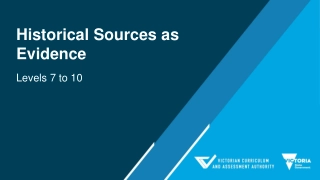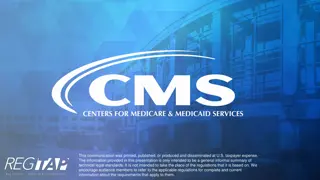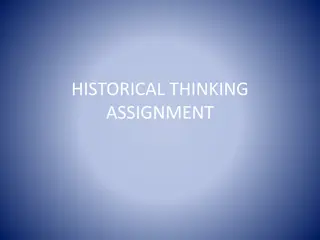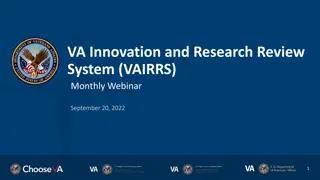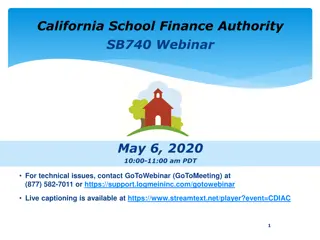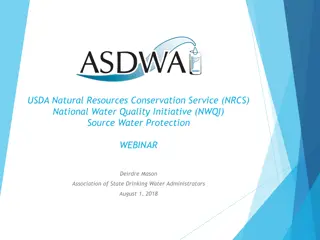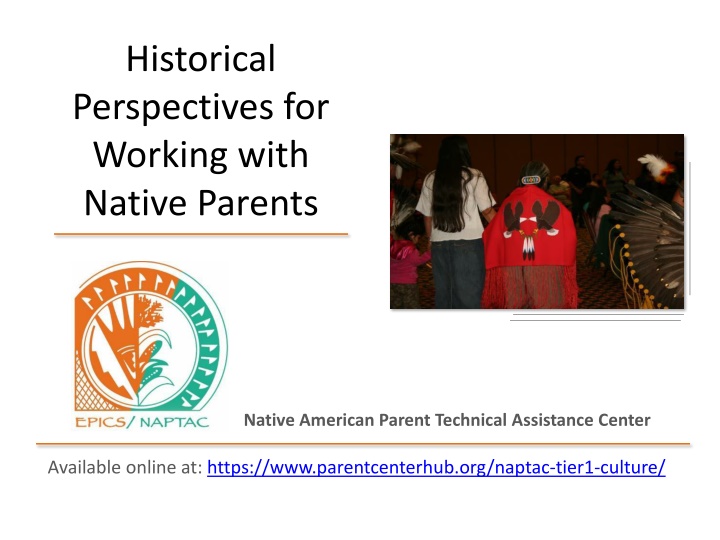
Historical Perspectives of Native American Education
Explore the historical perspectives of Native American education, from pre-contact tribal cultures to the impact of boarding schools. Learn about the challenges faced by Native parents and communities in the education system. Discover the implications for staff and what can be done to support Native education today.
Download Presentation

Please find below an Image/Link to download the presentation.
The content on the website is provided AS IS for your information and personal use only. It may not be sold, licensed, or shared on other websites without obtaining consent from the author. If you encounter any issues during the download, it is possible that the publisher has removed the file from their server.
You are allowed to download the files provided on this website for personal or commercial use, subject to the condition that they are used lawfully. All files are the property of their respective owners.
The content on the website is provided AS IS for your information and personal use only. It may not be sold, licensed, or shared on other websites without obtaining consent from the author.
E N D
Presentation Transcript
Historical Perspectives for Working with Native Parents Native American Parent Technical Assistance Center Available online at: https://www.parentcenterhub.org/naptac-tier1-culture/
Overview of Presentation Pre-contact tribal education Early non-Native education Institutionalizing Native education Boarding schools Scars from the boarding school era Key historical reports Change of heart: Federal funds for AIAN education Implications for staff: What needs to happen now?
Bingo! You ll need the Participant Bingo Card 1. Sign your name in the center square 3. Learn as you go 4. Going for a blackout, but call out when you have a BINGO in any direction 2. Sign only one square for another person
Pre-Contact Native cultures were intact Parents and extended families cared for children Whole communities taught children Experience-based education was used Values like courage, love, generosity, and respect for the environment and others were taught
Early Non-Native Education As early as 1744, an Indian elder described members who returned from schools of the white man, as being unfit for tribal life, not able to speak the tribal language well, unfit to be counselors, and hence unable to make worthwhile contributions to the tribe.
Institutionalizing Native Education Children were removed from their families and sent hundreds of miles from their communities Treaty-signing period ended around 1871 Philosophy was to kill the Indian, save the man Education was dispensed outside of Native communities
Boarding Schools for Natives Many boarding schools were housed in old military institutions Boarding schools became the primary institution encouraging assimilation of American Indian/Alaska Native (AIAN) youth Children s hair was cut, and they were punished for speaking their tribal language Different views of history and religion were taught and were vastly different from tribal realities
Grim Realities of the Boarding School Era Consequences? Tribal communities & parents were to have nothing to do with their children s formal schooling Tribal community mistrust of education Loss of traditional child-rearing practices School curriculum lacked accurate Native content Their only job was to send their children to school Changed roles & expectations of parents Deep scars remain
Key Reports Documenting Status of Native Education Meriam Report (1928) | Found that Federal Government policies had dramatically eroded tribal lifestyles, governments, and economic positions Indian Education : A National Tragedy, a National Challenge (1969) | Echoed earlier reports Indian Nations at Risk Study | Papers and White House Conference on Indian Education (1991-1992) President s Executive Orders on Indian Education (2000/2004)
Change of Heart: Federal Funds for Indian Education Congress authorized targeted funds to improve Indian education Johnson O Malley(PL 81-874, 1958) | Funds were allocated to provide supplemental services for Native children Indian Education Act (1972) | Reauthorized in 1974, 1988, 1992, 1994, & 2015 Native American Languages Act (PL 101-477, 1990/ 1992)
Implications for Parent Centers Renewed Parent Center commitment, time, energy, resources, & prioritizing of funds for outreach Improved outreach to Native parents and families Training on how schools can take a proactive role in supporting Native parents in ways that reinforce school learning Additional incentives as necessary to entice Native parents & school staff to attend Parent Center trainings
What else needs to happen? Extra efforts need to be made to reassure Native parents that schools truly recognize who Native students are and what is important to their community
Suggestions & & Observations Individual tribal history is important for school staff to know for each community Native parents may need additional skills so they can support their children s school learning What Indian communities are in your state? In your schools? Parent Centers can help develop this training for repeated offerings
Suggestions & & Observations School staff may need support on how to integrate Native history, language, and culture into the curriculum Parent Centers & Native communities can work individually and together to advocate for and support such efforts


